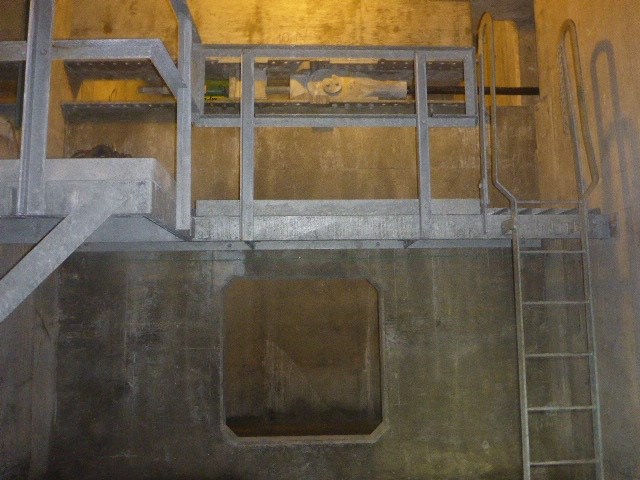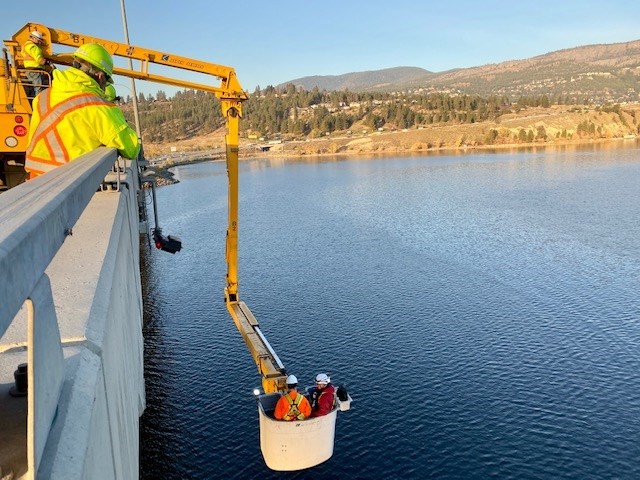
William R Bennett Bridge during construction.
Image Credit: Submitted/Kevin Hamakawa
December 27, 2020 - 12:00 PM
We know that the William R. Bennett Bridge across Okanagan Lake has to float — the soil structures just couldn't handle the weight — but have you ever wondered how the thousands of tonnes of concrete and steel actually stay afloat?
It’s one of only eight floating bridges in the world and the only one in Canada, making it an engineering oddity.
About 700 metres of the one-kilometre long bridge sits on eight giant concrete pontoons, each one weighing between 3,000 and 7,000 tonnes.
Kevin Hamakawa is the person responsible for ensuring those pontoons don’t leak. He leads a crew of five who not only make sure the bridge floats properly but are responsible for plowing snow, cleaning up garbage and removing graffiti on the bridge.
They also inspect the inside of the hollow concrete pontoons three times a year to make sure they’re not leaking.
“We’ve not ever had any water in there other than condensation,” Hamakawa told iNFOnews.ca. “We’ve had a couple of instances where a hatch was sealed with a pebble or whatever in the seal so a little bit of rainwater gets in there so there’s wet concrete on the floor. It has always just been rainwater or condensation.”
READ MORE: Why the Okanagan Lake bridge has to float
Six of its pontoons are 90 metres long, one is 25 metres and one is 60 metres for a total floating expanse of 705 metres, Hamakawa said, although he was speaking from memory and did not have the exact specifications if front of him. Another source says the floating part is 690 metres.
They are bolted together to make a rigid structure like a roof truss that resists wave action and changes in the elevation of the lake.
The massive concrete pontoons, which were built near Bear Creek Provincial Park and floated into place, are essentially hollow boxes that float because the weight of the water they displace is more than what they weigh themselves (Archimedes’ principle).
But they’re not exactly hollow.
“They are more like a honeycomb inside,” Hamakawa said. “There is a network of interior walls so that, if a tugboat rams into the side and water starts going in, only one small compartment fills up. We wouldn’t even know it. It wouldn’t change how the bridge floats. There’s 828 compartments so one compartment is a very small percentage of the buoyancy.”

Inside one of the pontoons
Image Credit: Submitted/Kevin Hamakawa
Each compartment is four metres square and most are five metres high.
Hamakawa and his crew do a detailed inspection once a year where they’re basically within arms length of each wall. Two other visual inspections are done just to make sure nothing is leaking.

Image Credit: Submitted/Kevin Hamakawa
The pontoons are anchored to the bottom of Okanagan Lake using a combination of new anchors that were installed for this bridge and old anchors that were used on the previous bridge. The old anchors are not the original ones used when the original Okanagan Lake Bridge opened in 1958. Those have been replaced over the years.
“To accommodate the seasonal fluctuations of the lake, we actually go in and adjust the tension of the anchors a couple of times a year,” Hamakawa said. “The cables are very long, so there’s stretch in them and that’s all designed into the loads that are in those cables as the lake goes up and down. It’s our adjustments that keep everything working in proper load ranges.”
Those anchors are inside the pontoons where the adjustments are made.
The level of Okanagan Lake can fluctuate several metres over the course of every year which means the bridge deck has to rise and fall as the lake level changes while still providing a smooth transition to the fixed ends on either side of the lake.
Expansion joints can be seen on the road surface. Below them are bearings that support the bridge deck. Together they act as hinges that allow the floating part of the bridge to rise and fall as needed while maintaining a smooth transition.
“That is the primary uniqueness of a floating structure, aside from the fact that there is a section that is floating,” Hamakawa said.
That smooth transition could change dramatically in the case of a severe earthquake because the bearings are energy-absorbing fuse-links designed to fail in an earthquake.
“(Fail) might not be the best word,” Hamakawa said. “They’re designed to absorb all the energy of an earthquake. There will be damage but it’s designed to happen at the bearings. It’s basically going to end up causing misalignment and stuff like that, not total destruction.
“In a major seismic event, we would have to close the bridge. There may be a little bit of horizontal misalignment. We would be able to put up a steel plate or maybe tighten a few bolts at one location so it keeps the emergency vehicles going.”
Hamakawa was involved right from the beginning as the pontoons were being built but he won’t be around when the bridge reaches its ultimate life span. Unlike the old bridge, this one was designed to last 100 years.
To contact a reporter for this story, email Rob Munro or call 250-808-0143 or email the editor. You can also submit photos, videos or news tips to the newsroom and be entered to win a monthly prize draw.
We welcome your comments and opinions on our stories but play nice. We won't censor or delete comments unless they contain off-topic statements or links, unnecessary vulgarity, false facts, spam or obviously fake profiles. If you have any concerns about what you see in comments, email the editor in the link above.
News from © iNFOnews, 2020